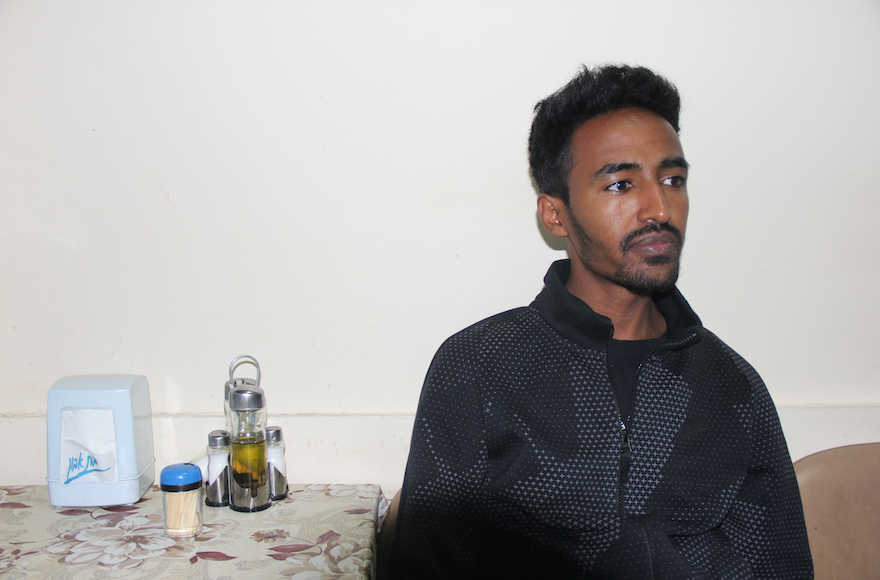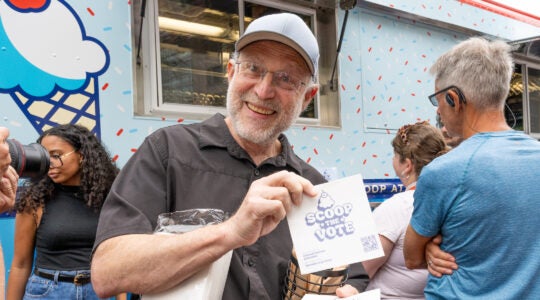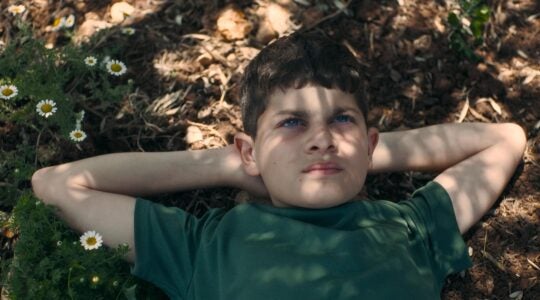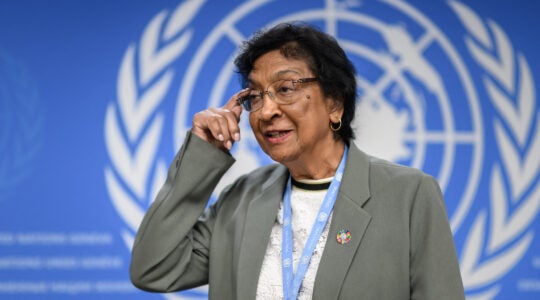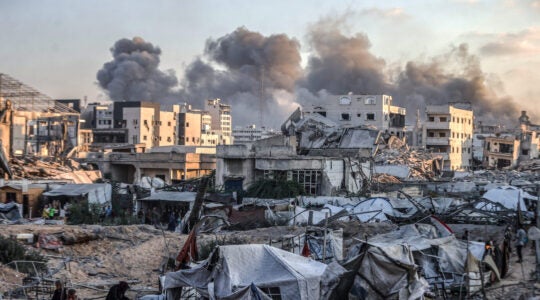TEL AVIV (JTA) — The Sudanese pizza restaurant is nearly empty on this weekday afternoon, but that doesn’t seem to bother its owner, Yakoub Al-Aldoum, who happily cooks goulash in a small, square kitchen.
Pizza, his specialty, will go into the oven in the evening, Al-Aldoum assures me repeatedly. He makes a regular crust with tomato sauce, then covers it with Sudanese staples like beans and lentils, or beef or tuna.
Al-Aldoum picked up pizza baking in a large restaurant in his home country of Sudan, then took the craft with him to Libya when he fled, seeking asylum.
Eleven years ago he arrived in Israel. Like tens of thousands of other African asylum seekers, he settled in the South Tel Aviv neighborhood of Neve Shaanan, next to the city’s grimy bus station, and found work in restaurants. He draws Sudanese customers, but also neighboring Eritreans, local Israelis and others.
“In Sudan, before, in Libya, we all worked in pizza,” said Al-Aldoum, 47. “I came here and there was no pizza. We worked with meat. Now we work with pizza and meat, beans, lentils, poultry — in every form. We make a little money here, a little money there.”
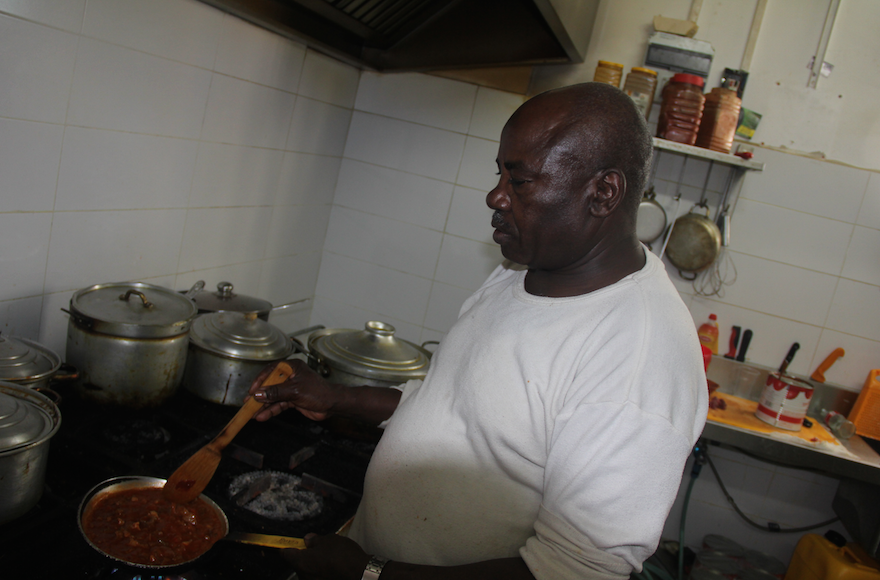
Yakoub Al-Aldoum cooks goulash in his restaurant kitchen. He opened up a fusion Sudanese-pizza place to diversify the neighborhood’s offerings. (Ben Sales)
Adjacent to the restaurant is a bar that’s easy to miss from the street. Its entrance is through a blue metal gate, cordoned off by a tarp and barbed wire. The only way to know it’s there is from a rectangular sign above the gate showing a smiling woman exhaling smoke from a hookah. The entrance leads into a dim courtyard covered by a tent.
A few African men are sitting on plastic armchairs drinking coffee and smoking hookahs , while a handful of others sit at a table with a red-and-white checkered tablecloth. Everyone is watching three TV screens showing, respectively, a pro wrestling match, a soccer game and an action movie that looks like “Top Gun” but isn’t.
Photos are not allowed. The owners do not give interviews.
Openness and suspicion, multiculturalism and insularity. These are two of the many contradictions that define Neve Shaanan, Tel Aviv’s diverse, underprivileged and vibrant neighborhood of asylum seekers, Filipino foreign workers, working-class Israelis and others.
It is at once an intricate tapestry of cultures and a labyrinth of competing identities. It is the hotbed of a years-long political and social fight that has torn Israel apart.
Neve Shaanan is also a neighborhood where many residents wake up in the morning, work all day, eat a quick meal and go to sleep.
“I do see and hear: ‘You’re like this, Sudanese are like this, Eritreans are like this,’” said Abdelaziz Muhammad, a Sudanese restaurant owner who arrived in Israel in 2008, referring to racism against Africans. “But I don’t see any problems here. We get along. South Tel Aviv is a nice neighborhood.”
If Israelis hear about Neve Shaanan, it’s probably because of the debate over African asylum seekers that has occupied the country for years. By 2012, more than 60,000 people, mostly from Eritrea and Sudan, had entered Israel illegally through its border with Egypt. They say they are refugees seeking asylum from war and brutal dictatorships at home. But the Israeli government contends that they are economic migrants seeking jobs and a better life in a developed country.
Since 2012, the Israeli government has tried to keep out asylum seekers and remove those already in Israel. It has erected a fence on its southern border, placed thousands of asylum seekers in a detention facility in southern Israel, offered incentives for them to leave and tried to negotiate deals with third-party countries to absorb them. By 2018, about 37,000 asylum seekers remained in Israel.
This year, the government struck a deal with the United Nations to transfer half of the asylum seekers to other developed countries while affording the other half legal status in Israel. But Prime Minister Benjamin Netanyahu abruptly backed out of the deal amid objections from Israeli residents of South Tel Aviv, who have portrayed the asylum seekers as a threat to their safety and their culture.
The changes in the neighborhood have been jarring to some of the older Jewish residents who have seen groups of young Sudanese and Eritrean men move into apartments once occupied by Jewish families like theirs. Ayala Sinvani, who has lived in the area for four decades, acknowledged that it’s always been a bad neighborhood, but said the new arrivals have disrupted the rhythm of life with loud music and unruliness in public. She feels that the government, which never paid much attention to South Tel Aviv, has abandoned it.
“There were always problems, but we managed to raise the standard of the neighborhood,” she said. “We were told everything was going to be OK. It was all lies. We want to go back to our normal life.”
Eli Shirazi, who has owned a storefront shoe shop on Neve Shaanan Street for 45 years, laments the drop in business he’s seen since both malls and asylum seekers began arriving in Israel.
Israelis, he said, are afraid to come to the neighborhood now. He accused asylum seekers of “craziness,” though police statistics show that the local foreign-born population has a below-average crime rate.
Although foreign residents, mostly African asylum seekers, make up a majority of residents of Neve Shaanan and its surrounding area, they accounted for less than a third of the crime rate from 2015 to 2017. Police have also beefed up their presence there. The station responsible for Neve Shaanan’s area grew from eight police officers in 2010 to nearly 200 last year — plus 50 border police officers.
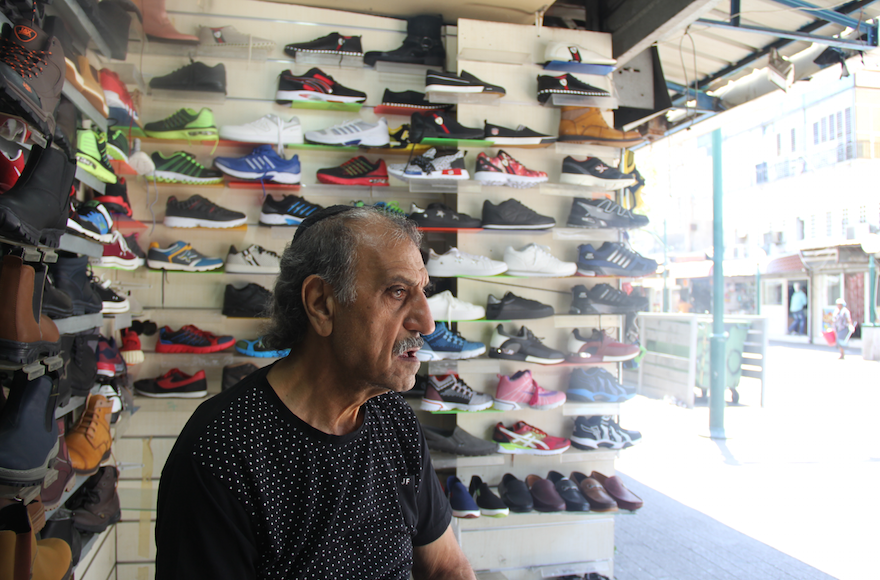
Eli Shirazi, who has owned a shoe store on Neve Shaanan Street for 45 years, bemoans the decline in foot traffic. He says Israelis are afraid to come to the neighborhood. (Ben Sales)
Shirazi, like his African neighbors, is an immigrant. He came from Iran with his family in 1958, when he was 14. He still longs for his boyhood home — “You don’t forget the place,” Shirazi said — but added his situation is different than that of the Eritrean and Sudanese. He feels a sense of belonging in a Jewish country, while he says that for them, Israel is just a place they have been able to stay.
“For us, there was someone who took care of us the right way, not like them,” said Shirazi, 74. “They have care, but we had a home here. We were coming to the land of Israel to stay.”
Neve Shaanan exists in the shadow of Tel Aviv’s Central Bus Station, a concrete behemoth that seems like it was designed by M.C. Escher on an off day. The neighborhood’s streets are shaped in semicircles, intended to look like a menorah on the map, and combine small storefronts with crowded, dilapidated apartment buildings and some new gentrified developments.
They are also dotted with unlicensed bars like the one next to the pizza place, called hamaras, that police have been trying to shut down. A large, relatively well-maintained park is across the street from the bus station, where children play on a swing set and drug addicts lay by the curb.
The main pedestrian avenue, Neve Shaanan Street, is a row of stores: There are Sudanese and Eritrean restaurants selling staples from their home countries. Next to them are barbers, clothing shops, phone shops and shoe stores. There are also some places to send money abroad. A few stores are owned by old-time Israeli locals, but in the evenings it’s largely populated by African locals.
According to Tel Aviv’s official statistics, Neve Shaanan has about 5,000 residents — part of a larger South Tel Aviv district with a population of 30,000. But the real number is much higher. An Israeli Knesset report from 2016 said that anywhere between almost 15,000 and 30,000 African asylum seekers live in South Tel Aviv — most of them in and around Neve Shaanan.
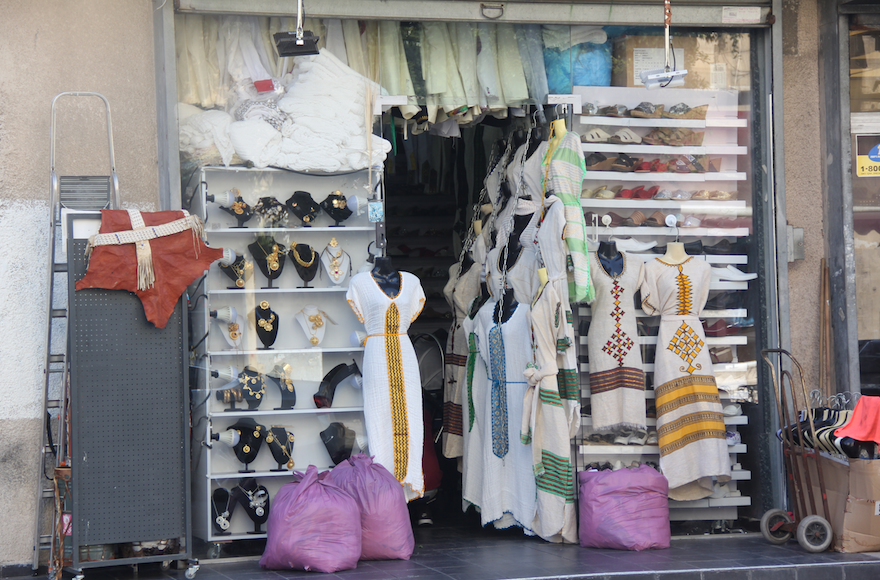
Shops like these around Neve Shaanan sell ceremonial dress for festivals such as weddings. Much of the clothing is white with embroideries. (Ben Sales)
“The neighborhood is very crowded,” said Haim Goren, who has lived in Neve Shaanan for 11 years. “It’s a neighborhood where 20,000 people live, where 30 years ago it was 5,000. There’s friction when you have tons of people on a small land area.”
The neighborhood was founded in 1921 by another set of refugees — Jews fleeing anti-Semitic violence in the adjacent Jaffa. Funded by foreign Jewish philanthropy, they eventually built a row of orchards that supplied Europe with fresh Jaffa oranges. In the 1920s, Tel Aviv incorporated the neighborhood and established its central bus station there in the 1940s, filling the streets with noise and pollution, and driving out anyone who could afford to move. So another set of refugees — recent immigrants to the new Jewish state — filled it up.
It was known, however, as the shoe district. In the era before ubiquitous malls, Neve Shaanan Street was where you went to buy footwear.
“It was a disadvantaged population throughout the years, a disadvantaged population remained here,” said David Cohen, a guide who does historical and culinary tours of Neve Shaanan. “By the ‘60s this was one of the most severe neighborhoods in Tel Aviv. Many of the apartments were empty, without renters. A lot of businesses closed, and that drew a lot of crime organizations.”
It was still a bad neighborhood in the early 2000s when asylum seekers began arriving from Africa. Because Neve Shaanan was next to the bus station and so neglected — with abandoned apartments and few police patrolling the streets — it was an easy place for illegal immigrants to settle. Asylum seekers filled the neighborhood as more than 40,000 came between 2010 and 2012.
Many spent their first few nights sleeping in Levinsky Park next to the bus station, then moved into small apartments where eight or 10 people slept on mattresses. Because the asylum seekers have few rights in Israel, they are prone to exploitation by landlords charging high rents and demanding payments in cash.
They have also consistently faced racism from locals as well as national politicians. In 2012, a mob attacked African residents of South Tel Aviv. Miri Regev, now Israel’s culture minister, called them a “cancer” (she later apologized). Official government documents refer to them as “infiltrators.”
The neighborhood has changed drastically with the influx of Africans, although even longtime residents can’t always agree how. Ayala Sinvani complained both that the African population was made up of young rowdy men — and that too many African children are crowding local schools.
“We are not living here, we are surviving,” said Teklit Michael, an Eritrean asylum seeker who came to Israel in 2008 and has since become an activist, serving as a spokesman for his community and helping fellow asylum seekers secure their rights. “You don’t know what’s going to happen the day after right now. You have to live as you can, to be safe for the day.”
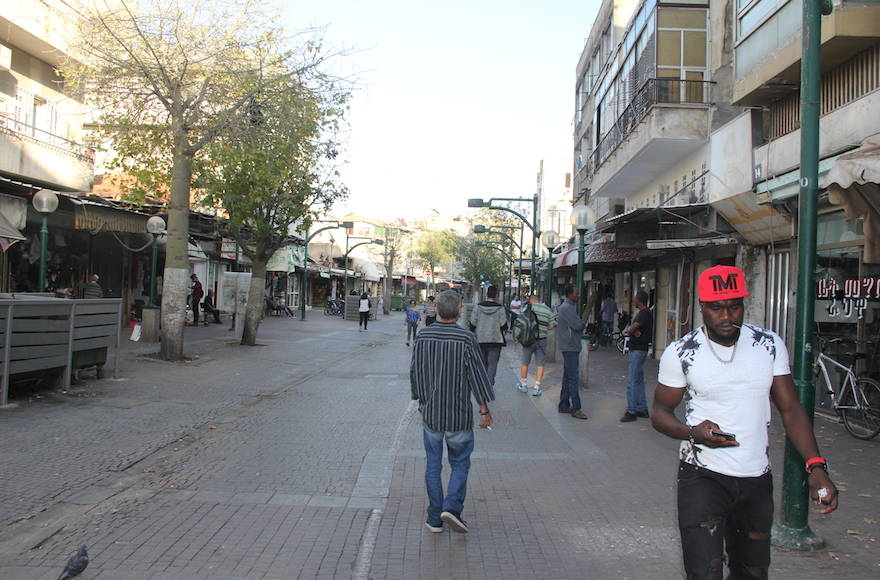
The neighborhood’s main pedestrian walkway, Neve Shaanan St., is lined with restaurants and small shops selling clothes, shoes and cellphones. (Ben Sales)
Last month, Michael was denied a checkbook by his Israeli bank.
African residents all said the same thing. They wake up early to go to service jobs — in restaurant kitchens, as busboys, factory workers or street cleaners — then come back at night, eat, have a cup of coffee or a smoke, then go to sleep. There are a few people making noise on the street, but life in the neighborhood is quiet. Because the population is largely single men, many of them spend their evenings eating with friends in restaurants, maybe watching a European soccer match, before retiring to bed.
Kids attend public school — one of the few guaranteed rights that Israel affords asylum seekers — and younger children often spend their days in unlicensed day care in people’s apartments. After dark, the playground in Levinsky Park is crowded with children as their parents relax on benches and picnic tables.
On weekends, many Eritreans will go to church. The churches, like many of the neighborhood’s establishments, are often unzoned.
Muhammad, the restaurateur, said he has a reliable crowd of 25 or 30 guys who sit at his rectangular tables each night. Most come in the evening, before he closes at 9:30, and will eat his menu based on Sudanese kisra bread or asida, a doughy dish served with tomato sauce. Then some will go to a hamara bar for some coffee and hookah for a half-hour or so. Then to bed.
“I just like my work,” he said. “I come from home to my place and then go back home. I have nothing else to do. I don’t know anything else.”
JTA has documented Jewish history in real-time for over a century. Keep our journalism strong by joining us in supporting independent, award-winning reporting.
